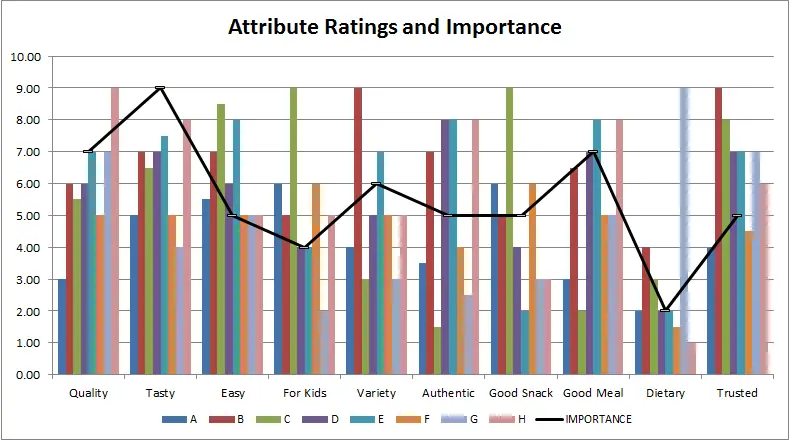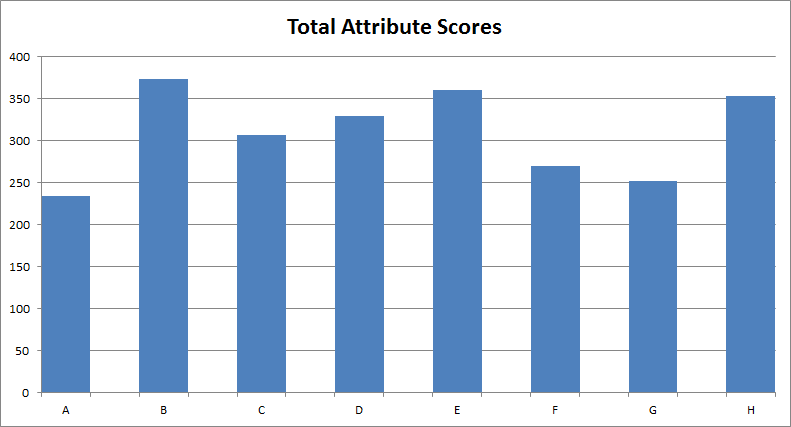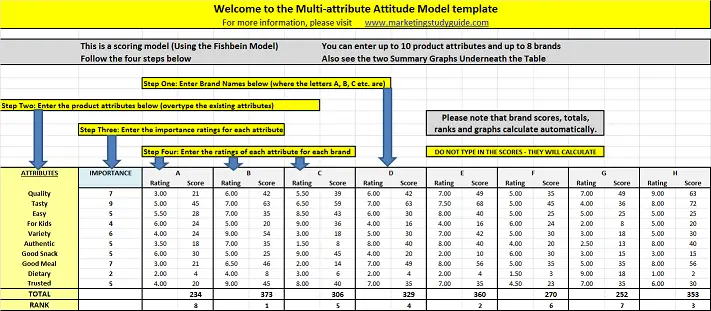- Here is the download link for the free Excel template: multi-attribute attitude model
Contents
Measuring Consumer Attitudes
A brand’s ability to measure consumer attitudes provides a very helpful insight into what is driving consumer behavior.
Generally a consumer’s attitude towards the various brands in the marketplace has a significant influence over their purchase and word-of-mouth actions. Positive attitudes will lead to positive behavior.
But attitudes are quite complex and have been formed possibly over many years of the consumer’s journey – based upon various brand exposures (touch-points), media and word-of-mouth communication, and possibly direct purchasing experience.
While it can be a challenging task to determine the various possible journey paths and range of brand touch-points – it is possible (via a market research survey) to get detailed information on the consumer’s attitude and build a multi-attribute attitude model.
Please scroll down for the link to the free multi-attribute attitude Excel spreadsheet template
Multi-attribute attitude model
As suggested by the name, this model breaks down the consumer’s overall attitude (that is, view of each brand) into smaller components. These components are the individual product features, functions and perceived benefits – which are collectively known as product attributes.
The structure of the market research questionnaire necessary to obtain the data to construct a multi-attribute attitude model would be:
- The researcher would determine (probably from initial focus groups) the key attributes of a product category
- Then for each main brand the respondent (consumer) would be asked to rate EACH brand for EACH key product attribute (on a scale, 1 to 7)
- The survey would then ask the respondent to also rate (on a scale) how important each attribute is to them in their purchase decision
Here is a graph output for a multi-attribute attitude model:
How to interpret the multi-attribute attitude model
The goal is to try and improve the consumer’s attitude towards our brand by concentrating upon the attributes where our brand is perceived weaker than key competitors AND for attributes that are ALSO important to the consumer.
Let’s assume that we are Brand A (first blue column) in this food market. Our better performing attributes (relative to competitors) are “for kids” (we are equal 2nd) and “good snack” (also equal 2nd) – BUT both of these are generally of lower importance to consumers in their purchase decision.
The consumer’s most important attribute is “tasty”, but Brand A is a lower relative performer – therefore, this is a potential attribute to improve (or improve the perception of) to improve the brand’s over score (see next section).
Overall score of the multi-attribute attitude model
Because we have scores for each attribute for each brand and the level of importance in the purchase decision, we are able to calculate an overall score for the consumer’s attitude towards the brand.
This score is then used as a point of comparison between the brands. A graphical example – using the same data as above – is shown below:
As we can see, Brand A has the lowest overall attitude score – which we should look to improve.
Therefore, we use the first graph showing the breakdown of the consumer’s attitude by product attribute and by importance in order to identify which areas that the brand/product should look to improve.
Free Excel template for creating a multi-attribute attitude model
- Here is the download link for the free Excel template: multi-attribute attitude model
When you open the spreadsheet it should look like the image below. Please note that there is example data in the template that you should delete.
FAQs on Multi-Attribute Attitude Models
What is a multi-attribute attitude model in consumer behavior?
A multi-attribute attitude model is a framework used to understand how consumers form attitudes and make decisions about products or services based on their perceptions of various attributes.
What is the mathematical formula for a multi-attribute attitude model?
The attitude (A) towards a product is calculated as the sum of the product’s attribute beliefs (b) multiplied by the importance weight (w) of these attributes. This is expressed as A = Σbi * wi.
What are some examples of product attributes?
Product attributes can include aspects like price, quality, brand reputation, design, features, performance, customer service, sustainability, and more. The significance of these attributes can vary greatly among different consumers.
How can a multi-attribute attitude model be useful for a marketer?
By understanding which product attributes are most important to consumers, marketers can tailor their strategies to highlight these attributes. This can influence consumer attitudes towards their products or services and ultimately drive sales.
Is a multi-attribute attitude model enough to completely understand consumer behavior?
No, while it provides a valuable starting point, consumer behavior is influenced by numerous other factors, including emotions, peer influence, personal experiences, and more. Therefore, it should not be used in isolation.
How can a company find out which attributes are most important to its consumers?
This can be done through market research techniques like surveys, focus groups, or data analytics. These methods can provide insights into consumers’ attitudes and preferences regarding different product attributes.
Can the importance of product attributes change over time?
Yes, the significance of different attributes can vary based on trends, changes in technology, societal shifts, and individual changes in consumers’ preferences and needs.
Can the multi-attribute model help in the development of new products?
Absolutely. By understanding which attributes are most valued by consumers, businesses can focus on enhancing those attributes in their new products, increasing the chances of a successful product launch.
How does the multi-attribute model influence advertising and promotions?
Understanding what consumers value most allows marketers to design advertisements and promotional material that highlight these attributes. This not only grabs the consumer’s attention but also creates a more favorable attitude towards the product or service.
Related Information



